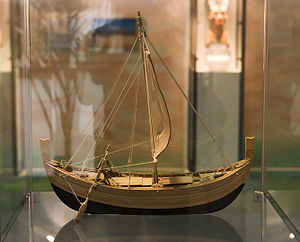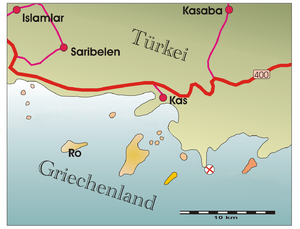Uluburun shipwreck
| Uluburun is Turkish for "Grand Cape". | |

Wooden model of the ship's reconstruction
|
|

Site of the wreck 50 m (160 ft) off the eastern shore of Uluburun, and 6 mi (9.7 km) to the southeast of Kaş, Turkey
|
|
| Location | Uneven slope of the headland's shelf, 44 m (144 ft) to 52 m (171 ft) deep, with artifacts down to 61 m (200 ft) |
|---|---|
| Region | Bay of Antalya, off the Turquoise Coast. |
| Coordinates | 36°7′43″N 29°41′9″E / 36.12861°N 29.68583°ECoordinates: 36°7′43″N 29°41′9″E / 36.12861°N 29.68583°E |
| Type | Site of a sunken ship |
| Length | About 10 m (33 ft) N-S, horizontal plot plan |
| Width | About 18 m (59 ft) E-W, horizontal plot-plan |
| Area | 180 m2 (1,900 sq ft), horizontal plot-plan |
| Height | Depth differential is 8 m (26 ft) vertical, with scattered artifacts, 17 m (56 ft) |
| History | |
| Builder | Unknown. The cargo was probably Syrian, deduced from the major type of ingot |
| Material | Wooden, single-mast, two-prow (stem, stern) sailing ship with one steering oar on a side |
| Founded | Built after 1305 BCE; date obtained by dendrochronological dating |
| Abandoned | Sank late 14th century BCE |
| Periods | Late Bronze Age |
| Cultures | Mycenaean, Cypriote, Syrian, judging by the pottery |
| Associated with | Crew of the merchant vessel |
| Events | Collision with the headland, perhaps wind-driven |
| Site notes | |
| Excavation dates | Excavational dives directed by George Bass in 1984, and Cemal Pulak in 1985-1994 |
| Archaeologists | George F. Bass, Cemal Pulak |
| Condition | Conservation, sampling and study are ongoing |
| Ownership | Republic of Turkey |
| Management | Institute of Nautical Archaeology, an international organization |
| Public access | Objects may be viewed in the exhibit at the Bodrum Museum of Underwater Archaeology |
| Website | "Uluburun, Turkey". |
The Uluburun Shipwreck is a Late Bronze Age shipwreck dated to the late 14th century BC, discovered close to the east shore of Uluburun (Grand Cape), and about 6 miles southeast of Kaş, in south-western Turkey. The shipwreck was discovered in the summer of 1982 by Mehmed Çakir, a local sponge diver from Yalıkavak, a village near Bodrum.
Eleven consecutive campaigns of three to four months' duration took place from 1984 to 1994 totaling 22,413 dives, revealing one of the most spectacular Late Bronze Age assemblages to have emerged from the Mediterranean Sea
The shipwreck site was discovered in the summer of 1982 due to Mehmet Çakir’s sketching of “the metal biscuits with ears” recognized as oxhide ingots. Turkish sponge divers were often consulted by the Institute of Nautical Archaeology's (INA) survey team on how to identify ancient wrecks while diving for sponges. Çakir’s findings urged Oğuz Alpözen, Director of the Bodrum Museum of Underwater Archaeology, to send out an inspection team of the Museum and INA archaeologists to locate the wreck site. The inspection team was able to locate several amounts of copper ingots just 50 metres from the shore of Uluburun.
With the evidence provided from the cargo on the ship it can be assumed that the ship set sail from either a Cypriot or Syro-Palestinian port. The Uluburun ship was undoubtedly sailing to the region west of Cyprus, but her ultimate destination can be concluded only from the distribution of objects matching the types carried on board. It has been proposed that ship’s destination was a port somewhere in the Aegean Sea.Rhodes, at the time an important redistribution centre for the Aegean, has been suggested as a possible destination. According to the excavators of the shipwreck, the probable final destination of the ship was one of the Mycenaean palaces, in mainland Greece.
Peter Kuniholm of Cornell University was assigned the task of dendrochronological dating in order to obtain an absolute date for the ship. The results date the wood at 1305 BC, but given that no bark has survived it is impossible to determine an exact date and it can be assumed that the ship sank sometime after that date. Based on ceramic evidence, it appears that the Uluburun sank toward the end of the Amarna period, but could not have sunk before the time of Nefertiti due to the unique gold scarab engraved with her name found aboard the ship. For now, a conclusion that the ship sank at the end of the 14th century BC is accepted.
...
Wikipedia
